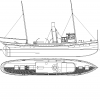-
Posts
6,360 -
Joined
-
Last visited
Reputation Activity
-
 wefalck got a reaction from Mike Y in Steel files vs. diamond files
wefalck got a reaction from Mike Y in Steel files vs. diamond files
In theory, files (with cutting ridges) are for metal and rasps (with individual cutting teeth) are for wood. Certain woods may dull quite quickly on wood or are too fine, so that they clog quickly and become ineffective, requiring frequent cleaning.
Diamond impregnated 'files' are similar in action to sandpaper, i.e. they have many, but geometrically not very well defined cutting edges. Diamond files come in many different price ranges and qualities, but unlike their grading is not as well established as for the 'cut' of files. So, unless you can inspect what you buy, it may be difficult to know what you get. Diamond files typically also have less well-defined edges, so are basically not suited to work on sharp inside corners.
In general, I am using cheap diamond nail-files (the first one I bought some 40 years ago and it is still in use) for working on flat surfaces, but steel needle-files for producing geometrically correct cut-outs etc. I found diamond needle-files less useful, except perhaps the round, rat-tail ones.
-
 wefalck got a reaction from mtaylor in Strip Vise Construction
wefalck got a reaction from mtaylor in Strip Vise Construction
I gather the engineering solution depends also on the expected plank width, not so much on its thickness. For the above pictured solution, which is simple and neat, one would need to get sharp-angled profiles - many drawn profiles are appreciably rounded at the corners, which makes holding very narrow strips difficult.
-
 wefalck got a reaction from vaddoc in Cutting Planks
wefalck got a reaction from vaddoc in Cutting Planks
I also had the issue with disc sanders taking off too much too quickly and made myself a little sander that allows to sand plank ends square and at angles:
I also constructed a miniature disc sander around a surplus watchmakers lathe. It is powered by a relatively slow-speed motor with controller. In this way the grinding process can be controlled better. For grinding I use either cheap diamond grit discs or flat discs with fine sandpaper glued on.
-
 wefalck got a reaction from thibaultron in Scanned bulkhead drawings into vector format?
wefalck got a reaction from thibaultron in Scanned bulkhead drawings into vector format?
Whether plans show the outside of the planking or the frames depends on the kind of plans. 'Real' plans are typically drawn to the outside of the frames, as they were used by the shipbuilder, who is not interested in the outside of the planking at this stage. Model reconstructions and the likes are usually drawn to the outside of the planking, on the other hand. It also depends on whether you talk about wooden or iron ships.
-
 wefalck got a reaction from mtaylor in Scanned bulkhead drawings into vector format?
wefalck got a reaction from mtaylor in Scanned bulkhead drawings into vector format?
Whether plans show the outside of the planking or the frames depends on the kind of plans. 'Real' plans are typically drawn to the outside of the frames, as they were used by the shipbuilder, who is not interested in the outside of the planking at this stage. Model reconstructions and the likes are usually drawn to the outside of the planking, on the other hand. It also depends on whether you talk about wooden or iron ships.
-
 wefalck got a reaction from mtaylor in Centering Tools
wefalck got a reaction from mtaylor in Centering Tools
The principle of the tool in the first post is neat, particularly for long, thin parts. I think I will go on to make one myself from metal.
I have used for years this centre-finder (about 50 mm long):
It was and still is a bit pricey at 52€, but this is what you have to pay for quality measuring tools.
-
 wefalck got a reaction from thibaultron in Coiling Lines Option
wefalck got a reaction from thibaultron in Coiling Lines Option
Shellac is indeed a good option too. I prefer the other type of varnish, which is a solution of cellulose-nitrate (also known as gun cotton :) ) in amylacetate, ethanol, and ethylacetate, because it stays slightly elastic and is not brittle. It is essentially the same as nail varnish.
-
 wefalck got a reaction from mtaylor in Cutting Planks
wefalck got a reaction from mtaylor in Cutting Planks
I didn't know about the 'Sand-It' sander when I made my own, but it follows the same 'guiding principle', namely the sandpaper is set into a recess, so that the sanding-block is guided as if in rails. One needs to clean the rails and the block frequently, so that the abraded material doesn't grind them down.
When designing the sander, I figured that my material would be rarely thicker than about 4 mm, so a sanding strip of 5 mmm width would be sufficient and provide for an economic use of the sandpaper.
Recently I started to experiment with sanding strips as used by dentists or dental technicians to smooth the side of teeth. These are plastic strips of about 5 mm width that are impregnated with diamond powder. They are available in various grades. I got them through ebay.
There are also steel-strips on the market that are impregnated with diamond powder. I found these very useful for various applications, but still have to design a method to fix them flat on the sanding block - I didn't envisage glueing them.
Glueing the sanding strips flat onto the block is an issue. Using spray-adhesive may be the answer, but I have not used it yet.
A short while ago I also bought a cheap needle file in China, about 20 mm wide and 200 mm long, which I want to use on the sanding device. Still have to figure out how to cut the file to size without ruining my cutting tools When filing wood and plastics, these diamond files should last forever. Perhaps one could be stuck to the 'Sand-it' sanding block. Alternatively, there are also now on the market various cheap diamond pads of different grade - apparently they are used to sharpen angling hooks and knives.
P.S.: Thanks @Altduck for your kind words on my tools 😇
-
 wefalck got a reaction from Mike Y in Cutting Planks
wefalck got a reaction from Mike Y in Cutting Planks
I also had the issue with disc sanders taking off too much too quickly and made myself a little sander that allows to sand plank ends square and at angles:
I also constructed a miniature disc sander around a surplus watchmakers lathe. It is powered by a relatively slow-speed motor with controller. In this way the grinding process can be controlled better. For grinding I use either cheap diamond grit discs or flat discs with fine sandpaper glued on.
-
 wefalck got a reaction from mtaylor in Coiling Lines Option
wefalck got a reaction from mtaylor in Coiling Lines Option
Shellac is indeed a good option too. I prefer the other type of varnish, which is a solution of cellulose-nitrate (also known as gun cotton :) ) in amylacetate, ethanol, and ethylacetate, because it stays slightly elastic and is not brittle. It is essentially the same as nail varnish.
-
 wefalck got a reaction from mtaylor in Cutting Planks
wefalck got a reaction from mtaylor in Cutting Planks
I also had the issue with disc sanders taking off too much too quickly and made myself a little sander that allows to sand plank ends square and at angles:
I also constructed a miniature disc sander around a surplus watchmakers lathe. It is powered by a relatively slow-speed motor with controller. In this way the grinding process can be controlled better. For grinding I use either cheap diamond grit discs or flat discs with fine sandpaper glued on.
-
 wefalck got a reaction from jud in Coiling Lines Option
wefalck got a reaction from jud in Coiling Lines Option
As I certainly stated here repeatedly, I never use CA glues for anything else, but proper joints. I certainly do not use it to re-enforce any rigging. The lacquer or varnish I use is called (in German) zapon-varnish. It cellulose-based and contains also components that keep it slightly elastic. It's main traditional use is to protect silverware and brass (instruments) from tarnishing.
The very varnish also keeps rope coils in place. Of course, one can use a lacquer or varnish as glue too.
Below a couple of pictures of various types of coils, all coerced in place with varnish. The first picture shows how the coils are shaped and kept in their place, while the solvent evaporates - usually in a few minutes.
-
 wefalck got a reaction from Jolley Roger in Cutting Planks
wefalck got a reaction from Jolley Roger in Cutting Planks
I also had the issue with disc sanders taking off too much too quickly and made myself a little sander that allows to sand plank ends square and at angles:
I also constructed a miniature disc sander around a surplus watchmakers lathe. It is powered by a relatively slow-speed motor with controller. In this way the grinding process can be controlled better. For grinding I use either cheap diamond grit discs or flat discs with fine sandpaper glued on.
-
 wefalck got a reaction from John Cheevers in Cutting Planks
wefalck got a reaction from John Cheevers in Cutting Planks
I also had the issue with disc sanders taking off too much too quickly and made myself a little sander that allows to sand plank ends square and at angles:
I also constructed a miniature disc sander around a surplus watchmakers lathe. It is powered by a relatively slow-speed motor with controller. In this way the grinding process can be controlled better. For grinding I use either cheap diamond grit discs or flat discs with fine sandpaper glued on.
-
 wefalck got a reaction from Altduck in Cutting Planks
wefalck got a reaction from Altduck in Cutting Planks
I also had the issue with disc sanders taking off too much too quickly and made myself a little sander that allows to sand plank ends square and at angles:
I also constructed a miniature disc sander around a surplus watchmakers lathe. It is powered by a relatively slow-speed motor with controller. In this way the grinding process can be controlled better. For grinding I use either cheap diamond grit discs or flat discs with fine sandpaper glued on.
-
 wefalck got a reaction from jud in Scanned bulkhead drawings into vector format?
wefalck got a reaction from jud in Scanned bulkhead drawings into vector format?
There is an intermediate method: scan the body plan with sufficient resolution and then import the picture into your (2D) CAD-program. You then can draw in another layer each bulkhead/frame half by tracing the scan with a vector line. It is useful, if your program has a spline-function or similar to smooth the hand-drawn curves. A graphics-tablet is also useful, but I have done it with the mouse or even a track-ball/-pad. Making the drawing big helps to even out the inaccuracies of tracing.
-
 wefalck got a reaction from JpR62 in Cutting Planks
wefalck got a reaction from JpR62 in Cutting Planks
I also had the issue with disc sanders taking off too much too quickly and made myself a little sander that allows to sand plank ends square and at angles:
I also constructed a miniature disc sander around a surplus watchmakers lathe. It is powered by a relatively slow-speed motor with controller. In this way the grinding process can be controlled better. For grinding I use either cheap diamond grit discs or flat discs with fine sandpaper glued on.
-
 wefalck got a reaction from Jim Rogers in Cutting Planks
wefalck got a reaction from Jim Rogers in Cutting Planks
I also had the issue with disc sanders taking off too much too quickly and made myself a little sander that allows to sand plank ends square and at angles:
I also constructed a miniature disc sander around a surplus watchmakers lathe. It is powered by a relatively slow-speed motor with controller. In this way the grinding process can be controlled better. For grinding I use either cheap diamond grit discs or flat discs with fine sandpaper glued on.
-
 wefalck got a reaction from Tigerdvr in Cutting Planks
wefalck got a reaction from Tigerdvr in Cutting Planks
I also had the issue with disc sanders taking off too much too quickly and made myself a little sander that allows to sand plank ends square and at angles:
I also constructed a miniature disc sander around a surplus watchmakers lathe. It is powered by a relatively slow-speed motor with controller. In this way the grinding process can be controlled better. For grinding I use either cheap diamond grit discs or flat discs with fine sandpaper glued on.
-
 wefalck got a reaction from Seventynet in Cutting Planks
wefalck got a reaction from Seventynet in Cutting Planks
I also had the issue with disc sanders taking off too much too quickly and made myself a little sander that allows to sand plank ends square and at angles:
I also constructed a miniature disc sander around a surplus watchmakers lathe. It is powered by a relatively slow-speed motor with controller. In this way the grinding process can be controlled better. For grinding I use either cheap diamond grit discs or flat discs with fine sandpaper glued on.
-
 wefalck got a reaction from puckotred in Centering Tools
wefalck got a reaction from puckotred in Centering Tools
The principle of the tool in the first post is neat, particularly for long, thin parts. I think I will go on to make one myself from metal.
I have used for years this centre-finder (about 50 mm long):
It was and still is a bit pricey at 52€, but this is what you have to pay for quality measuring tools.
-
 wefalck got a reaction from druxey in Centering Tools
wefalck got a reaction from druxey in Centering Tools
The principle of the tool in the first post is neat, particularly for long, thin parts. I think I will go on to make one myself from metal.
I have used for years this centre-finder (about 50 mm long):
It was and still is a bit pricey at 52€, but this is what you have to pay for quality measuring tools.
-
 wefalck got a reaction from Canute in Centering Tools
wefalck got a reaction from Canute in Centering Tools
The principle of the tool in the first post is neat, particularly for long, thin parts. I think I will go on to make one myself from metal.
I have used for years this centre-finder (about 50 mm long):
It was and still is a bit pricey at 52€, but this is what you have to pay for quality measuring tools.
-
 wefalck got a reaction from thibaultron in Coiling Lines Option
wefalck got a reaction from thibaultron in Coiling Lines Option
As I certainly stated here repeatedly, I never use CA glues for anything else, but proper joints. I certainly do not use it to re-enforce any rigging. The lacquer or varnish I use is called (in German) zapon-varnish. It cellulose-based and contains also components that keep it slightly elastic. It's main traditional use is to protect silverware and brass (instruments) from tarnishing.
The very varnish also keeps rope coils in place. Of course, one can use a lacquer or varnish as glue too.
Below a couple of pictures of various types of coils, all coerced in place with varnish. The first picture shows how the coils are shaped and kept in their place, while the solvent evaporates - usually in a few minutes.
-
 wefalck got a reaction from Ferit in Coiling Lines Option
wefalck got a reaction from Ferit in Coiling Lines Option
As I certainly stated here repeatedly, I never use CA glues for anything else, but proper joints. I certainly do not use it to re-enforce any rigging. The lacquer or varnish I use is called (in German) zapon-varnish. It cellulose-based and contains also components that keep it slightly elastic. It's main traditional use is to protect silverware and brass (instruments) from tarnishing.
The very varnish also keeps rope coils in place. Of course, one can use a lacquer or varnish as glue too.
Below a couple of pictures of various types of coils, all coerced in place with varnish. The first picture shows how the coils are shaped and kept in their place, while the solvent evaporates - usually in a few minutes.




.thumb.jpg.6fd4c1b78768bb3efd745ab810936005.jpg)











